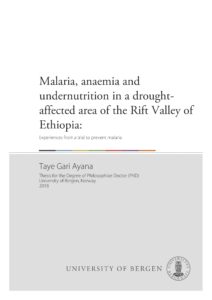Taye Gari. Malaria, anaemia and undernutrition in a drought-affected area of the Rift Valley of Ethiopia: Experiences from a trial to prevent malaria. PhD. University of Bergen, 2018. Bergen
Summary of PhD thesis
Background: In Ethiopia, malaria, anaemia and undernutrition are common childhood health problems. The country is planning to reduce these conditions to a level where they are not a public health problem. Meanwhile, for the success of this aim, a description of the occurrence and interaction of malaria, anaemia and undernutrition could help contribute to design tailored, efficient and effective control strategies. This study was done in the context of malaria prevention trial, which aimed to measure the effect of combining long-lasting insecticidal nets (LLINs) and indoor residual spraying (IRS) in reducing the malaria incidence compared to LLINs or IRS alone. The study area was affected by a serious drought and famine during the first year of the study.
Objectives: The overall aim of this thesis is to improve our understanding of the effect of malaria prevention on anaemia, and to assess the association between malaria, anaemia and undernutrition among children in a drought-affected area in south-central, Ethiopia.
Methods: A cohort of 5309 residents was followed-up for 16 weeks to measure the variations in malaria incidence among villages (Paper I), and the results were used as a baseline to calculate the sample size needed for the trial. We followed a cohort of children aged 6 to 59 months for one year to describe anaemia and changes in haemoglobin (Hb) concentration (Paper II). A cohort of 4468 children was followed-up for 89 weeks to measure the relationship between malaria and undernutrition (Paper III). Weekly home visits and patient self-referral were also used to identify malaria cases. We conducted Hb concentration (once a year) and anthropometry (twice a year) surveys.
Results: In Paper I, we observed a variation in malaria incidence among villages. On the other hand, the insecticide-treated nets ownership was low (27%), with the distance from the lake or river and younger age being the main risk factors for malaria. The findings of this study were used as a baseline to calculate the sample size for the trial. In Paper II, despite the malaria prevention effort in the community, we observed an unexpected increase in anaemia prevalence over the period of a year, which could be due to the drought and famine that affected the area. A higher incidence of anaemia was observed among children with stunting, malaria infection, young age and in poor families. However, no significant difference in anaemia prevalence was observed among the different trial arms (LLIN+IRS, LLINs alone, IRS alone and routine arm). In Paper III, malaria infection was a risk factor for stunting and wasting, although undernutrition was not a risk for malaria infection. Furthermore, an increase in the prevalence of stunting, but no significant change in a prevalence of wasting was observed over time.
Conclusions: We showed a large variation in malaria incidence among villages. Conducting trials in a drought-prone area may bring an unexpected challenge. We observed an unexpected increase in anaemia prevalence over a year. There was no significant difference in anaemia prevalence among the trial arms. Moreover, a close follow-up of the nutritional status of children with malaria infection may be needed. There could hence be a need to prioritize villages nearer to the main mosquito breeding sites for malaria control.
Trial registration: PACTR 201411000882128 (8 September, 2014)

